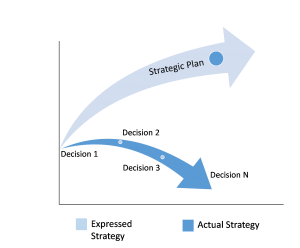Assessing the “Intent” in Strategic Intent – Pt. 1
I recently took an executive education course in which I was asked the question, “What is Strategy?”
As I listened to a myriad of answers, all of which could have been correct in my opinion, the course instructor put a counter-intuitive spin on the answer. “Strategy” as it pertains to business always seems to give the connotation of plans for future action. Most of us tend to think of “strategy” as planning for future shifts in the business landscape whether it be financial, technological or competitive. However, on this particular day, our instructor put a more practical, honest and pointed spin on the definition of “strategy”. He defined an organization’s strategy as “the sum of a series of decisions made over a period of time regarding the operation of the business”.
The definition made me take pause. The translation of our instructor’s definition in my head was, “Don’t tell me what your strategy is, or even read it to me from some well-crafted statement developed in some workshop. Show me your strategy through the business decisions that have been made.” Such a simple statement is also very pointed in today’s ultra-political corporate environment. Decisions are not always (and in some cases, rarely) made from a place of strict adherence to strategic intent.

Following the course, I quickly challenged my team and myself to revisit the impactful decisions that were made regarding our organization over the course of the last year. Once we had a sufficient inventory of data points to consider, we dogmatically evaluated each against our expressed strategic intent. Not only did we evaluate how closely the decisions aligned with our expressed strategic intent but we also evaluated the motivation for making the decision to begin with. This prevented us from getting “accidental credit” for decisions that ended up being “right” but were made for the wrong reasons. While I won’t divulge the conclusion of our exercise, I’m sure you can imagine that there were times that we had to swallow a large bitter pill to accept flawed decision-making. While the exercise was certainly enlightening, it was the awareness it created around the need to challenge our decision-making on a regular basis that showed itself to be the real fruit.
By
Jamal Starr, President/CEO – Starr & Associates
